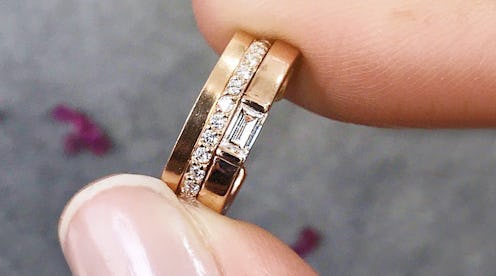(Fashion)
Diamond-Buying Advice Everyone Should Read Before Investing In a Ring

The utter stress of buying a diamond ranks right up there with filing your annual income taxes, meeting your partner's family, and other equally anxiety-inducing life experiences. After all, there's just so much to know going into the whole ordeal. Cut, clarity, color, carats — not to mention settings, bands, certifications, and of course a little thing called: the budget. It's a complicated topic that can quickly become vastly overwhelming, especially if you're sans any advice on how to buy a diamond other than a run-of-the-mill Google search.
However, if you've made it this far, rest assured because you're in good hands. Whether you're selecting a sparkler for an engagement ring, or more generally for your jewelry box, you'll want to take a few notes. Before you head to a local diamond district or look somewhere online like Blue Nile or Diamond Foundry to select your stone, read on.
Often the best way to cut through the clutter is by going straight to the experts. Ahead, read from four jewelry industry insiders including gemologists, designers, business founders (and all of the above) to learn about secret hacks to more efficiently purchase a diamond. Whether it's not getting hung up on the carat weight of your bling (seriously, 1.98 and 2 carats are basically the same thing) to more technical tricks involving fluorescence and inclusions that can help save money while maintaining quality. It's a fascinating treasure trove of information and it's all available to you below. Have at it!
Fluorescence
"Under UV light some stones fluoresce. Ideally, you don't want a fluorescent stone; however, if you are buying a color J [note: gems range from D (clear) through Z (slight color)] and below you may actually seek it out. Fluorescence can make a stone with a hint of color actually appear whiter. Too much fluorescence and your stone might look cloudy." — Renna Taher, Founder of Renna
Avoid the Magic Numbers
"When shopping for a diamond, most tend to think in round numbers — one carat, two carat, etc. Diamond cutters know this and do all they can to hit those 'magic numbers.' Since the price per carat jumps, a small weight difference becomes a significant price difference. A 1.98 and 2 carat stone will look nearly identical to the naked eye. Focus on how the stone looks, not numbers on the certificate. Avoid the magic numbers and you’ll save money without sacrificing quality." — Emily Goldstein, Founder of EF
Inclusions Aren't the End of the World
"Actually look at the map of inclusions on your GIA certificate. Not all inclusions are the same. Some are black some are clear, some are in the center of the stone, some are at the bottom or side. Each stone is different. If you are buying a stone with an inclusion, is it in a spot that you can place a prong so you can cover it up?" — Renna Taher, Founder of Renna
Don't Overthink Design
"I advise my clients to start the custom engagement ring process by first setting their ideal budget range. This starting point will help dictate where to focus spending their money on, whether it’s cut, color, clarity or size. If the budget allows, I suggest focusing on color and clarity first because I believe the stone should speak for itself and not be overwhelmed by its design." — Halleh Amiralai, Founder of Halleh
Depth Percentage
"Opt for a 'shallow' stone. A shallow 2.00 carat stone will have a bigger outline than a 'deep' stone. Although they might weigh the same, face up they will vary greatly. Ideal depth percentage is considered 57.5-63%. Look for a stone in the 53-55% range, this range is considered shallow but not terribly so. If you go too shallow, you will compromise on brilliance, because light will enter the stone and leak out the bottom instead of refracting back up and out through the top of the stone." — Renna Taher, Founder of Renna
Sacrifice Color Over Cut
"In my opinion the first thing you should look at when purchasing a diamond is the cut grading. This determines how the stone will interact with light, and in turn, how much the stone will sparkle. Make sure to purchase a stone where the cut grading is at minimum 'Good' or 'Very Good' to really see your diamond shine! Even with a higher carat and color, a diamond with a poor grading cut will be less shiny and bright." -— Camille Parruitte, Creative Director of Nouvel Heritage
Rethink Round
"Round stones tend to have approximately a 10% premium on other shapes. Opt for another shape!" — Renna Taher, Founder of Renna